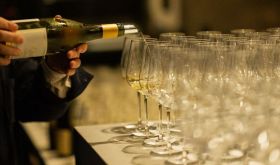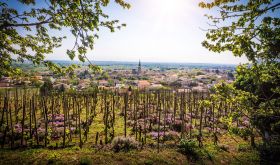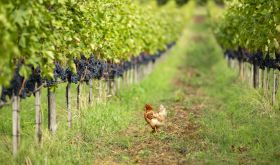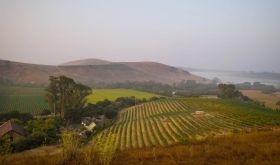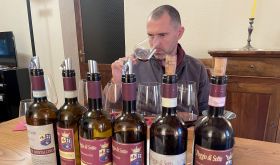31 Dec 2001 It's difficult to be first, and even more difficult to be first and successful. Most of the world's wine producers spend their lives following rather than leading. And, as in most fields, the person popularly credited with blazing a trail is often not the first person along it but the first person to realise its significance.
Cloudy Bay, New Zealand, is a perfect example of this. For all its fame, Cloudy Bay was far from the first producer of Sauvignon Blanc grown in Marlborough in the north of the South Island. NZ's largest wine company Montana was the true pioneer. But it took an outsider, David Hohnen of Cape Mentelle winery in Western Australia, to identify just how special this combination could be and to sell it to the outside world via an unforgettable name and label. Cloudy Bay Sauvignon Blanc has been rationed to gasping fans around the world since the early 1980s, while Montana has only just launched its wares in a serious fashion in the US, under the placename Brancott to avoid confusion with the American state of Montana. [See The man who dreamt up Cloudy Bay – JR 2015]
Pesquera, Ribera del Duero, was another trailblazing example of reinvention rather than pure invention. Spain's high-altitude, north-western plateau on the banks of the Duero river (upriver from Portugal's Douro valley) was already famous for one producer, Vega Sicilia. But whereas Vega Sicilia's serious, long-lived wines were the (occasionally volatile) product of long-term ageing in old barrels, local blacksmith Alejandro Fernandez instigated a more modern barrel ageing regime and combined it with stringent cellar hygiene and ruthlessly rigorous vine-growing. The result was reds with great concentration and glamour that could be drunk relatively young, and a horde of wannabe Pesqueras which need extremely careful selection. Alion, Teofilo Reyes and Hacienda Monasterio are generally reliable, indeed sometimes surpass Pesquera nowadays. Pingus has trumped it. [See Trad v modern – a comparative tasting – JR 2-15]
Le Pin, Pomerol. It is difficult to be innovative in a country with as long a winemaking tradition and such strict controls as France (as Jean-Louis Denois of Domaine de l'Aigle is finding in his battles with the authorities to be allowed to plant the great Riesling grape in the cool vineyards of Limoux). The ground is more likely to be broken in the cellar than the vineyard. And Jacques Thienpont of the Belgian family with considerable holdings in Bordeaux could claim to have broken – for better or worse – entirely new ground when he hand-crafted the first microchâteau wine at Le Pin in 1981. [See Inside Le Pin video – JR 2015]
Le Pin was a hard sell at first (I bought a case of the 1983 for £150 in 1985) but by the mid 1990s it had outstripped Petrus in price and, in some quarters, reputation. Le Pin has inspired a legion of 'garagistes', producers lavishing minute care on a few barrels to eke maximum effect on the market out of a small patch of soil, not just on Bordeaux's right bank but as far afield as California, Australia and southern Europe.
Most of the rest of my list of trailblazers can be divided into two camps, old and new. The first comprises those whose pioneering work was sufficiently long ago that they have established a trend, either by preserving something precious that was under threat or by developing an entirely new style of wine that has since been followed by the mainstream.
Craiglee, Victoria, kept the Australian Shiraz flame alive throughout the late 1970s and early 1980s when market forces, besotted by Cabernet Sauvignon and Chardonnay, threatened to extinguish it. The same job was done for the Pinotage grape by Kanonkop, South Africa, and arguably for the California equivalent Zinfandel by Ridge Vineyards, California [see Ridge retrospective – JR 2015]. Both Shiraz and Zinfandel have been so unfashionable as to have been subjected to the ignominy of being required to produce 'white' (palest pink) wine in their time.
In Portugal, Luis Pato, Bairrada, is trying with almost more energy than seems possible to maintain the traditions of this northern wine region. These include most notably persistence with the indigenous grape Baga, which, most inconveniently for the pace of 21st century life, requires long ageing [See Luis Pato's reds – a match for fine bordeaux, and also Baga strikes back for those who have followed him in his Baga crusade. The picture above is of Luis Pato, taken from his website. See also Luis Pato's latest releases – JR 2015]
The most obvious example of a grandaddy trailblazer in Italy was Tignanello, Tuscany [actually, I'd say it was Sassicaia – wonder why I overlooked it in this article – JR 2015]. As a wine style it was so successful that nowadays it seems extraordinary that small new oak barrels, low yields and the Cabernet Sauvignon grape were so novel in most of Italy in the early 1970s when Antinori first made this blend of local Sangiovese and Cabernet in the style of red bordeaux.
Nearly 20 years later, Alvaro Palacios, Priorat, could be said to have refined much the same exercise, begun in the 1980s [read the story in When Eric met Daphne – JR 2015] in the Gratallops enclave within this fashionable Catalan appellation with, in the case of his luxury-priced rarity L'Ermita, shades of Le Pin.
Grace Family, Napa Valley, was arguably the first California cult Cabernet, if such is defined by micro production and mailing-list-only sales policy. To the north Eyrie Vineyard, Oregon, showed the way for American Pinot Noir [see The Eyrie longevity revelation – JR 2015], while Mount Mary, Victoria did the same for its Australian counterpart.
But these are all examples of looking back, an unfashionable exercise for this time of millennium. Who will be proved to have been the trailblazers of this new century? I would nominate the following for starters:
- Fairview, South Africa, for being several years ahead of its neighbours in terms of varietal range and being notably successful with Viognier and Shiraz/Mourvèdre blends [and for improving workers' lives and conditions – JR 2015]
- L'Ecole 41, Washington, for persisting with Sémillon whose day must surely come [still not – JR 2015]
- Planeta, Sicily, a family whose surname just happens to sound like a hyper-modern brand, for doing so much to prove that this beautiful Mediterranean island deserves to belong to the greater world of wine [see Sicily – Italy's new California and The resurrection of Mamertino – JR 2015]
- Casa Lapostolle, Chile, for continued excellence, not least with its new Clos Apalta Merlot, which may not quite conform to the single-vineyard model yet but is already just one of several stunning Chilean reds
- Catena, Argentina, my nomination for wine producer of this new decade, for applying high intelligence to a country with enormous potential. Catena Alta Malbec points the way
- And finally, Nyetimber, England, chosen not for reasons of chauvinism (the grapes may grow in my native country but they are vinified using French expertise by a couple of American expats) but because it has proved that England can produce some seriously fine wine, by sticking as closely as possible to the recipe for champagne [see How well does English fizz age? – JR 2015].




